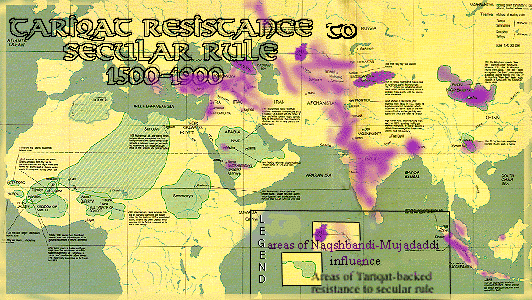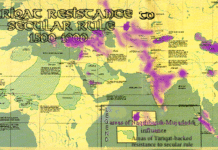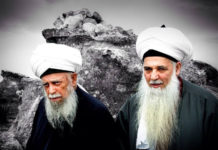From its advent, religion was beset with enemies from within and without, who tried to destroy its very foundations and pillars: sometimes through outright atheism but more often through free- thought and corruption. In general, spiritual-minded people today no longer have advisors and teachers who possess the caliber to counsel them and to train them in the teachings of the prophets and saints. Unfortunately, they do not find guides capable of leading them in the teachings of Islam on that high road of morality and ethics that constitute religion’s essential character.
On the contrary, today we see cases of would-be scholars (ulema) who are not only unscholarly, but are also ignorant and sometimes even corrupt. Indeed, in many places, they have gotten the upper hand and now prominently occupy seats of religious authority. Sunk in lives of pleasure and good living, they play at the role of guiding and advising and preaching to the Muslim community but in reality they have cast aside the simple lifestyle and regimen of self-denial practiced by the Prophet (s), his Companions (r) and those of the generation immediately succeeding them.
Confronted with this situation, how can we not ask: In which direction is our Umma (Community) headed?
It is true that timely measures could have been taken by communities to prepare good and wise scholars whose unstained lives would have allowed them to function as models and to undertake the mission of reminding the Nation of the Prophet (s) of the message brought forth in the Qur’an and the Sunnah (Way of life of the Prophet (s)). Then, our condition would have been improved and we would have been rewarded and lifted to those stations that Allah ordained for us both in this life and in the Hereafter.
The situation was not always as I have described it. On the contrary, it used to be that this sacred mission, this great service of calling the Umma to remembrance of its proper heritage framed by the Qur’an and set out in the Prophet’s Sunnah, was performed by devoted and sincere scholars of spirituality. These individuals, in time, came to be known by the name of safa, a word derived from the Arabic safa’a which means “to purify,” because of the assiduousness with which they applied themselves to holding firmly to the Sunnah and employing it to purify their character from all defects in behavior and morality.
The Schools of Purification (tazkiya)
We know for example, that in the first century after the Hijra, renunciation of the world (zuhd) grew as a reaction against worldliness in the society. Derived in principle from the order of Allah to His Righteous Apostle to purify people [Qur’an 2:129, 2:151, 3:164, 9:103, 62:2], the practitioners of this way clove firmly to the Prophetic way of life as it was reflected in the lives of his Companions and their Successors, in the ways they employed to purify their hearts and character from bad manners and to inculcate in their own selves and in those around them the manners and upright moral stature of the Best of Mankind, the Prophet Muhammad (s).
Through slow evolution, this regimen ended up as a school of practical thought and moral action endowed with its own structure of rule and principle. This became the basis used by Sufi scholars to direct people on the Right Path. As a result, the world soon witnessed the development of a variety of schools of purification of the ego (tazkiyat an-nafs). Sufi thought, as it spread everywhere, served as a dynamic force behind the growth and fabric of Islamic education. This tremendous advance occurred from the first century after the Hijra to the seventh, in parallel with the following developments:
Development of the bases of fiqh (Law and Jurisprudence), through the Imams (r).
Development of the bases of caqidah (System of Belief) through al-Ashcari and others;
Development of the science of hadith (Sayings of the Prophet (s)), resulting in the six authentic collections and innumerable others;
Development of the arts of nahu and balagha (Speaking and Writing Arabic).
Tariqat or “path” is a term derived from the hadith of the Prophet (s) ordering his followers to follow his sunna and the sunna of his successors. The meaning of sunna is “path,” “way,” which is also the meaning of taraqat referred to in the Qur’anic verse, “Had they kept straight on the path (tariqat), We would have made them drink of a most limpid water” [72:16]. Tariqat thus came to be a term applied to groups of individuals belonging to the school of thought pursued by a particular scholar or “shaikh,” as such a person was often called.
Though these shaikhs applied different methods in training their followers, the core of each one’s program was identical. The situation was not unlike what we find in faculties of medicine and law today. The approach in different faculties may be different, but the body of law, the state of art in medicine remains essentially the same everywhere. When students graduate from these faculties, each student bears the stamp of its character. Yet, none are considered less a lawyer or doctor because their respective affiliations differ.
In a similar way, the student product of a particular shaikh will bear the stamp of that shaikh’s teaching and character. Consequently, the names given to various schools of Sufi thought differ according to the names and the perspectives of their founders. This variation manifests itself in a more concrete fashion, in the different supererogatory devotions, known as awrad, ahzab or adhkar, used as the practical methodology of spiritual formation. Such differences, however, have nothing to do with the religious principle. In basic principle, the Sufi schools are essentially the same.
The Sufi regimen under which individuals undertook the path to Allah, was a finely-honed itinerary which charted the course of inward and outward progress in religious faith and practice (din). Following the tradition of the Companions of the Prophet (s) who used to frequent his company named Ahl as-suffa (“the People of the Bench”), the practitioners of this regimen lived a communal life. Their dwelling-places were the mosque-schools (zawaya), border forts (ribat), and guest-houses (khaniqah) where they gathered together on specific occasions dedicated to the traditional festivals of the Islamic calendar (cid). They also gathered on a regular basis in associations for the conveying of knowledge (suhba), assemblies to invoke the names of Allah and recite the adhkar (plural of dhikr, “remembrance”) inherited from the Prophetic Tradition, and circles of study in Islamic law. Yet another reason for their gathering was to hear inspired preaching and moral exhortations (wicaz ).

Legend:
green – Areas of Tariqat-backed resistance to secular rule
purple – areas of Naqshbandi-Mujaddadi influence
The shaikhs exhorted their students to actively respond to Allah and His Messenger (s), to cleanse their hearts and purify their souls from the lower desires prompted by the ego and to reform erroneous beliefs. All this was accomplished by cleaving to the Prophetic Sunnah. The methods of remembering Allah which they instilled in their students were the very same methods passed down from the Prophet (s). In this way, they propagated upright behavior both through word and deed, while they encouraged the believers to devote themselves to Allah Almighty with their whole hearts. The aim of their endeavor then was nothing less than obtaining Allah’s satisfaction and inspiring love for His Prophet (s). In short, what they aimed for was a state where God would be pleased with them even as they were pleased with God.
These shaikhs therefore were the radiant beacons that dispelled darkness from a believer’s path as well as the solid cornerstones upon which the Ummah could build the foundations of an ideal society. The ideal here was the spirit of sacrifice and selflessness that characterized their every effort. These values, in time, imbued the entire social fabric of Islam.
The guesthouses, for example, were more often than not found in neighborhoods of the poor and economically disadvantaged. Needless to say, for this reason they became remedies for many social ills.
As a result of such teaching and training we find that many students of Sufi shaikhs graduated from their course of studies fully empowered to carry other people’s burdens, even as they strove to illumine the way of Truth. Furthermore, through their training and self-discipline they had developed the manifest and decisive will to do so. Genuine scholars and teachers of tariqat leave no stone unturned in conducting their jihad, a word which means both the physical struggle against unbelief and the spiritual struggle against the unseen allurements that trap the soul.
History books are filled with the names of Sufi mujahidin (People Who Struggle) and shuhada (Martyrs) that have devoted their lives to confronting the enemies of the faith and calling mankind to the divine Presence of Allah, as well as calling back those who had deviated form the true path and the Sunnah of the Prophet (s). They accomplished this with wisdom and they were effective. Their names and stories are too numerous to list in the span of a single book, even if it had hundreds of volumes.
It suffices to say that the lives of these Sufi Shaikhs are overwhelming evidence that Sufism, far from encouraging escapism and quietism that impedes social progress, upheld the highest values of social consciousness as well as religious inquiry and science. In fact, they provide adequate testimony to an unremitting jihad and struggle against social injustice and social inaction that took place over the centuries.





































